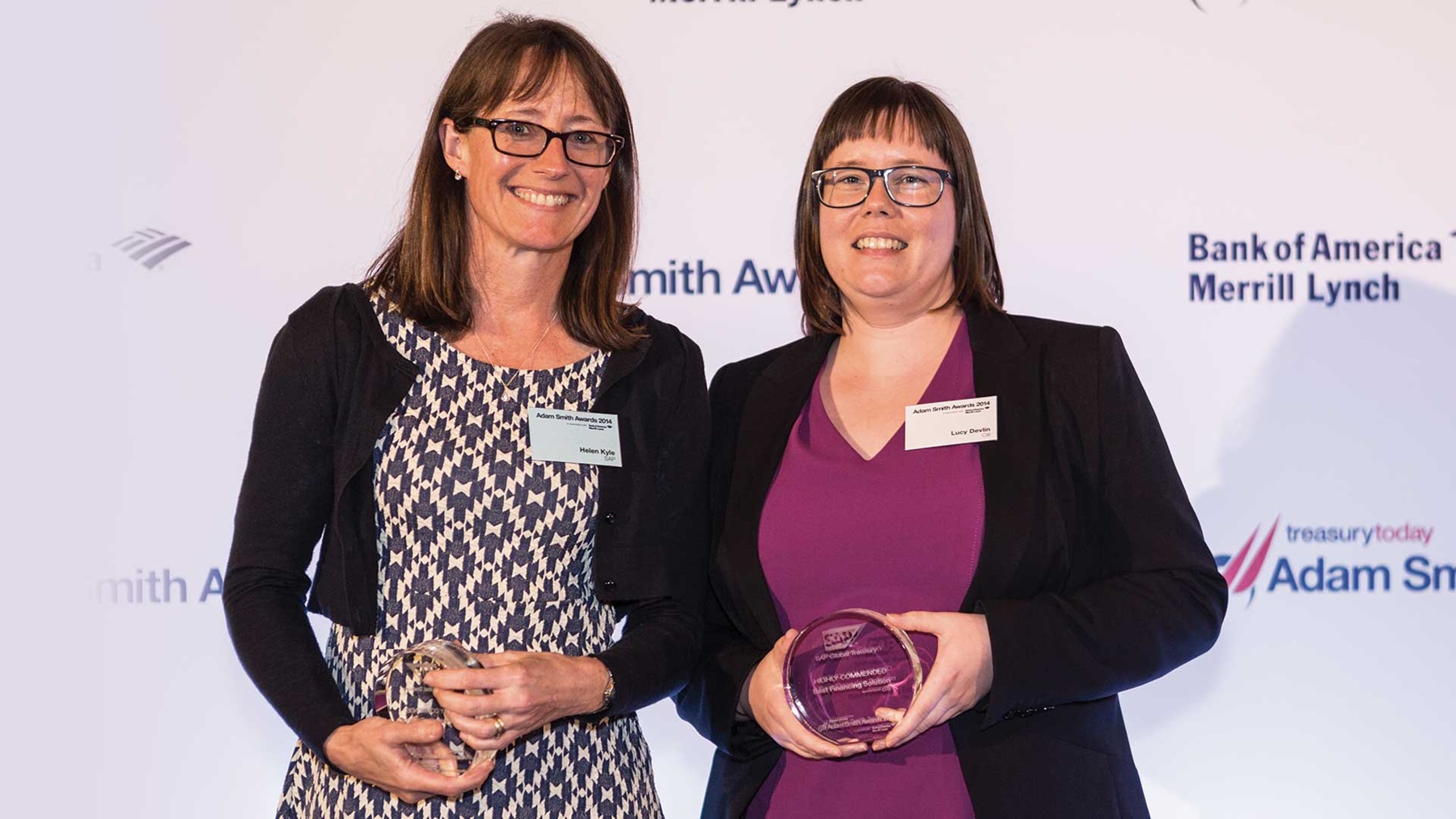
Photo of Helen Kyle of SAP collecting on behalf of Steff en Diel and Lucy Devlin of Citi.
SAP wanted to refinance its existing revolving credit facility (RCF) in order to reduce both margins (the potential interest expense) and bank charges (the yearly commitment fee), optimise the documentation, and create a leaner bank relationship management process.
Steffen Diel
Global Treasury, Head of Treasury Finance

SAP AG is a multinational software corporation, headquartered in Walldorf, Germany, with operations in more than 130 countries. The company is the world’s leading provider of enterprise application software, business analytics and enterprise mobility – with more than 253,000 customers and almost 67,000 employees worldwide.
in partnership with

The challenge
SAP wanted to refinance its existing revolving credit facility (RCF) in order to reduce both margins (the potential interest expense) and bank charges (the yearly commitment fee), optimise the documentation, and create a leaner bank relationship management process.
To achieve this, the company decided to establish a two-tier system for its banking partners, with differentiated access to additional treasury business. The banks placed in tier one would be granted access to all treasury business, while the tier two banks would be excluded from certain areas. In addition, the size of the facility was adjusted given SAP’s growth strategy and transition into the cloud (the facility increased from €1.5 billion to €2 billion). The key challenge was to introduce the new tiered structure to the participating banks while increasing the facility amount.
The solution
To overcome the challenge the company openly communicated the purpose of the new structure to its banks, which would offer improved mapping of credit commitment levels to the portfolio of accessible treasury business. SAP also clearly stated to the participating banks its expectation as to which tier it believed would be best suited for each bank.
While we anticipated some resistance from the banks to follow our proposal, it turned out that it was fully understood and supported by the respective banks.
Steffen Diel, Global Treasury, Head of Treasury Finance
“While we anticipated some resistance from the banks to follow our proposal, it turned out that it was fully understood and supported by the respective banks,” explains Steffen Diel, Global Treasury, Head of Treasury Finance at SAP.
SAP achieved a 100% hit rate with the invited banks, with all 27 agreeing to sign the final credit facility agreement on 13th November 2013. From this date the €2 billion RCF became effective. The Bank of Tokyo- Mitsubishi, Landesbank Hessen-Thüringen, Citigroup, and Deutsche Bank all acted as book-runners to this transaction. Allen & Overy LLP Frankfurt was SAP’s legal adviser.
Best practice and innovation
Using a two-tiered structure, segregating banks into two different credit commitment levels is a real first for SAP. This structure helps to optimise bank relationship management through offering a leaner approach. The tiered structure also assists in setting clear expectations towards the banks regarding any ancillary business opportunities.
Innovation was shown through the soft market sounding process. The treasury team called every individual bank on the pre-defined list in order to explain the targeted terms and conditions. The experience with the soft market sounding was very positive, based on providing the utmost transparency at an early stage, close alignment with the banks’ relationship managers and optimised process management. The result was a 100% hit ratio (ie none of the invited banks dropped out) and a significant oversubscription of more than 60%.
“The successful refinancing of SAP’s syndicated revolving credit facility once again acknowledges SAP’s strong financial position and excellent reputation in the capital markets,” says Diel.
Key benefits
Through this project SAP has secured lower financing costs, with a tenor of five years (with two one-year extension options). Furthermore, through the adjustment of the existing core bank group, the RCF is able to better support SAP’s global growth strategy, especially in emerging markets. For example, a Chinese bank was successfully invited to facilitate SAP’s operations in Asia.
The new facility also reached one of the lowest credit margins for German companies (reduced from 45bps to 22.5bps) and a stronger pricing than other German A-rated corporates in transactions in 2012/2013.
In brief, SAP achieved:
- A reduction in bank charges (yearly commitment fee).
- Increase in facility amount to €2 billion (from €1.5 billion).
- Lower margins (reduction of potential interest expense).
- Optimisation of portfolio of participating banks.
- Leaner bank relationship management.